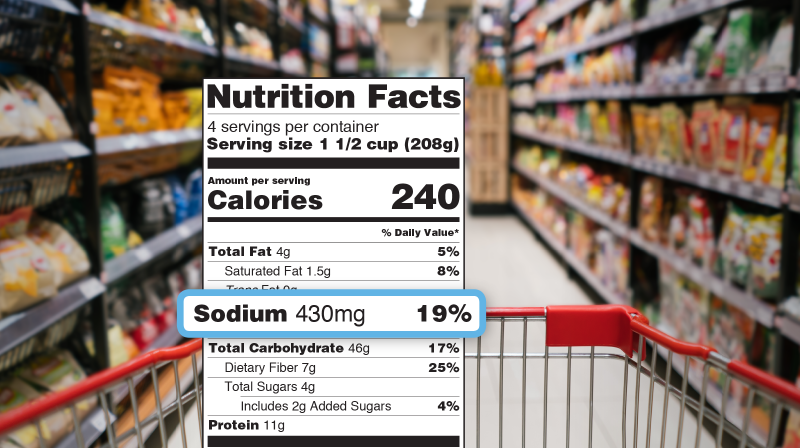The new recommendations from the Food and Drug Administration suggest food manufacturers and restaurants need to take initiative toward reducing salt.
Lowering Sodium in the Food Supply
The Problem

The majority of sodium consumed comes from processed, packaged and prepared foods, not from table salt added to food when cooking or eating. This makes it difficult for all of us to control how much sodium we consume.
Some companies have reduced sodium in certain foods, but many foods continue to contribute to high sodium intake, especially processed, packaged and prepared foods, including foods eaten away from home.
The Public Health Need
Americans consume on average 3,400 milligrams (mg) of sodium per day—nearly 50%more than the 2,300 mg limit recommended by federal guidelines for people 14 years and older. Recommended limits for children 13 and younger are even lower.
Most children and adolescents also eat more sodium than is recommended.
Too much sodium can raise blood pressure, which is a major risk factor for heart disease and stroke.
More than 4 in 10 American adults have high blood pressure and that number increases to almost 6 in 10 for non-Hispanic Black adults. Additionally, about one in 10 children (8-12 years) and one in 8 teens (13-17 years) has elevated or high blood pressure.
Reducing sodium intake has the potential to prevent hundreds of thousands of premature deaths and illnesses in the coming years.
The Science
Strong scientific evidence supports lowering sodium intake from current levels.
The science supporting the relationship between sodium reduction and health is clear: When sodium intake increases, blood pressure increases and high blood pressure is a major risk factor for heart disease and stroke – two leading causes of death in the U.S.
The FDA’s goal to reduce sodium intake is consistent with the Dietary Guidelines for Americans, 2020-2025 and the 2019 National Academies of Sciences, Engineering, and Medicine Dietary Reference Intakes Report on Sodium and Potassium. External Link Disclaimer
The FDA’s Approach
To gradually reduce sodium across the food supply, the FDA is taking an iterative approach that includes establishing voluntary sodium targets for industry, monitoring and evaluating progress, and engaging with stakeholders.
Final Guidance
The FDA issued the final guidance with voluntary targets for reducing sodium in commercially processed, packaged and prepared food over the next 2.5 years. The approach supports sodium reduction efforts already made by industry, provides common targets for defining and measuring progress, and provides companies with the flexibility and time to meet these targets.
The FDA’s approach encourages a level playing field by setting voluntary targets for both processed and restaurant foods.
To achieve a significant impact, the FDA is especially encouraging adoption by food manufacturers whose products make up a significant proportion of national sales in one or more categories and restaurant chains that are national and regional in scope.
Voluntary Targets
There are 16 overarching categories with individual sodium targets for 163 subcategories of food in recognition that a one-size approach does not fit all.

The targets in the final guidance are designed to support decreasing average daily sodium intake by about 12 percent—from approximately 3,400 milligrams (mg) to 3,000 mg.
The targets take into consideration the many functions of sodium in food, including taste, texture, microbial safety and stability. The targets do not address naturally occurring sodium or salt that individuals add to their food.
Next Steps
The FDA will monitor the sodium content of the food supply, evaluate progress towards achieving the targets in the final guidance and engage with stakeholders on sodium reduction efforts and the targets.

Based on that information, the FDA expects to issue revised subsequent targets in the next few years to facilitate a gradual, iterative process to reduce sodium intake.
Frequently Asked Questions on FDA’s Sodium Reduction Strategy
What is the FDA doing?
Americans are consuming too much sodium in their diet, and the majority comes from processed, packaged and prepared foods, not the salt shaker. That is why we developed the final guidance with sodium reduction targets to encourage industry to gradually reduce sodium in a wide range of foods over the next 2.5 years.
Which foods are highest in sodium?
Sodium is added to almost all processed, packaged and prepared foods. Some individual foods are known to be high in sodium, but it’s also important to consider how often the food is consumed. Other foods may be lower in sodium, but are often consumed in greater amounts and/or more frequently. Commonly consumed foods such as deli-meat sandwiches, pizza, burritos and tacos, soups, savory snacks, pasta dishes, burgers and egg dishes are known to contribute significantly to sodium intake. Some high-sodium foods, such as dried fish, do not contribute as much to overall sodium intake because they typically aren’t consumed in large quantities, or as often.
Why is sodium added to food?
Sodium is added to processed, packaged and prepared foods for a wide variety of reasons. For example, it is used to control microbial growth, which can cause food to spoil and can cause foodborne illness. Sodium also is used to improve flavor and texture, and for baking and curing meat. While sodium is necessary for many reasons, today’s food supply contains too much sodium.
Why is reducing sodium in foods important?

Too much sodium contributes to high blood pressure, which can lead to heart attacks and strokes. Americans now consume on average about 3,400 milligrams (mg) of sodium each day, while federal guidelines recommend less than 2,300 mg per day for people 14 years and older. Recommended limits for children 13 years and younger are even lower. Reducing sodium in foods could prevent hundreds of thousands of premature deaths and illnesses over a decade.
How strong is the science on the benefits of sodium reduction?
Strong scientific evidence supports lowering sodium intake from current levels. Excess sodium intake increases risk for high blood pressure, heart disease and stroke. The Dietary Guidelines for Americans, 2020-2025 recommends limiting sodium intake to 2,300 mg per day for people 14 years and older; and even less for those 13 years and younger.
What if I don’t have these health problems?
More than 100 million American adults have high blood pressure, and blood pressure generally rises as you get older. This tendency for blood pressure to rise with age is seen mostly in western countries where sodium intakes are high. Children and adolescents also are more likely to have increased blood pressure with higher sodium intakes. Studies suggest that the preference for sodium is affected by early life consumption habits and can extend into adult years, although palates can also adjust to lower sodium in foods.
Can’t people just check the labels on foods in the supermarket?
Consumers can, and should, check labels when they are available, but a few types of foods do not require the Nutrition Facts label. An example is deli meats you buy at a counter. Even with labeling, consumers still have a difficult time eating the recommended amount of sodium because sodium levels in today’s overall food supply are just too high. The majority of the sodium we eat comes from processed, packaged and prepared foods, not from table salt added to food when cooking or eating.
Why are you including restaurant foods?
Americans eat about one-third of their food calories and spend about half of their food dollars outside the home, so it’s important that restaurants are part of the solution, along with the rest of the food industry. Including restaurant foods is necessary to achieve sodium reduction goals and for people to adapt their taste buds whether they are eating at home or outside the home.
Won’t foods with less sodium taste bad?
The sodium in your diet comes from a lot of different types of foods—especially mixed dishes that have many components and sauces. Our approach is to encourage reductions in a variety of products—not just ones that are especially high in sodium. This way, we aren’t recommending drastic reductions that will significantly affect the taste of food. We carefully studied the range of popular foods in today’s marketplace to see what reductions are possible based on what some companies are already doing and what is selling well in the marketplace.
We also know that people usually don’t notice small reductions (about 10 percent) in sodium. And, over time, people’s taste buds get used to these changes, especially if they are made gradually. In addition, there are other ways companies can reformulate, or change, certain foods while still making them appealing to consumers. Examples include adding savory herbs and spices, salt blends or other flavorings in place of sodium.
Haven’t many companies already come out with lower sodium foods?
Yes, some food companies are making progress already and we applaud their leadership. But even with these efforts, the sodium content of the food supply remains high. Part of the problem has been the focus on making a few foods very low in sodium, instead of making most foods a little lower in sodium. We want to give the industry common targets across a broad range of foods.
When will I see changes in sodium in the foods I buy?
We are encouraging companies to meet short-term targets in two and a half years (note that some foods already meet the short-term targets). We expect that if the food industry reaches these initial targets more broadly, it would reduce average sodium intake to about 3,000 mg per day.
Are other countries making similar efforts to reduce sodium in foods?
Yes. There are 96 countries working to reduce the sodium intake and 48 have set sodium target levels for one or more processed foods. The World Health Organization rates sodium reduction as a “Best Buy” to improve public health. It is difficult to compare countries in terms of progress because sodium intake varies worldwide, and different approaches may be needed based on foods typically eaten. But many countries, such as the United Kingdom and Canada, have made progress on sodium reduction with approaches similar to that being used here.
How will you know if companies are making progress in reducing sodium?
A key part of the FDA’s sodium reduction plan is to monitor progress toward our goals on a regular basis to understand changes that are occurring. We will work with other government agencies, such as the U.S. Department of Agriculture and the Centers for Disease Control and Prevention on these monitoring efforts. The FDA also plans to actively engage with food manufacturers to learn about their sodium reduction efforts. Source FDA





